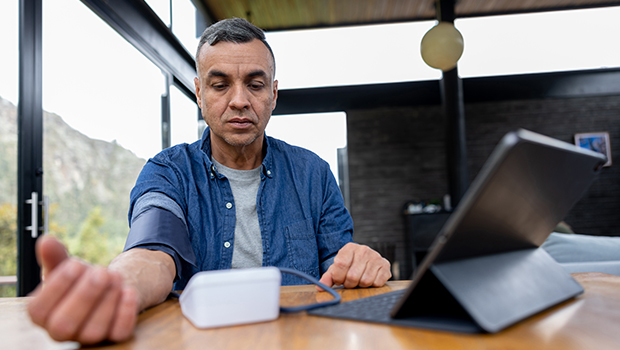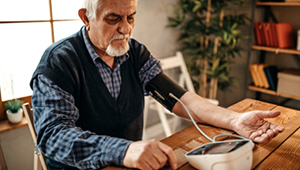Home blood pressure monitoring: From study to clinic

Beverly Green, MD, MPH, and Kaiser Permanente work to improve hypertension care
Some Kaiser Permanente Washington members with hypertension, or high blood pressure, are sending blood pressure measurements that they take at home to their medical records. More members may start soon, as pilot programs for blood pressure monitoring at home are underway, based in part on research from Beverly Green, MD, MPH, Kaiser Permanente Washington Health Research Institute senior investigator and Washington Permanente Medical Group physician.
"Our BP-CHECK randomized trial found that measuring blood pressure at home was accurate for diagnosing hypertension,” Green said. “Home monitoring performed better than other methods we tested, including visiting a clinic."
Stanley Shyn, MD, PhD, Washington Permanente medical director of population health, explained why the organization is exploring home monitoring. "Diagnosing or managing hypertension based on a single reading taken in clinic is very limited," he said, "because blood pressure varies over time for both hypertensive and normotensive patients." (Normotensive means having blood pressure in the normal range.) Home measurements taken at different times of day may collectively better represent a person's blood pressure.
Remote monitoring for high blood pressure
Kaiser Permanente has telemedicine programs that provide members with remote support for managing some conditions. For example, Kaiser Permanente Washington has a Hypertension Chronic Disease Management Program, in which members with high blood pressure use telemedicine to work with a clinical pharmacist or registered nurse to manage their condition — for example, by adjusting medications. This year, the program added Remote Patient Monitoring that allows participants to upload home blood pressure readings to their electronic health record through a mobile device. Coordinator of Pharmacy Clinical Programs Bryan Davis, PharmD, said, "We found it saved time for clinical pharmacists to have patient readings automatically entered in their records."
Assistant Manager, Population Management, Tiana Wright, RN, and Davis are leading pilot work to expand and automate aspects of this program into primary care. "We're still in the information-gathering phase," Wright said, "but we're automating the identification of patients who might have uncontrolled hypertension. They then get a secure message inviting them to participate in home monitoring."
Eligible patients with a smartphone who are willing to try automated entry of home blood pressure readings into their medical record are enrolled in Remote Patient Monitoring. If they need a home blood pressure monitor that sends readings via smartphone, they can borrow one. Davis explained that an automated system monitors patients' readings and refers them to additional care, if necessary. That might include entering the Chronic Disease Management Program or connecting to emergency services for critically high blood pressure readings.
Automated identification of patients who might have chronically high blood pressure started at 4 Kaiser Permanente Washington clinics in October — Rainier, West Olympia, Ballard, and South Lake Union — and just added another Olympia site. The team expects about 550 patients will be invited to enroll in home blood pressure monitoring. Wright explained that working with these patients will show how many respond to the invitation to participate and then how many have controlled blood pressure or need referral to more care. This information will help with improving and scaling up the home monitoring program.
The reception so far is enthusiastic. "Clinics want this program," Wright said. "Kaiser Permanente leadership is also very interested in making programs for home blood pressure monitoring more broadly available."
The Washington Permanente Population Health Team — including Tina Shah, MD, and Jacquelyn Rios, MBA, MS — is developing an additional pilot tool. This is for people with or without a hypertension diagnosis who don't have a current blood pressure reading in their record or whose last reading was high. The tool doesn't require a smartphone and, instead, lets members enter their home blood pressure readings through the Kaiser Permanente secure online patient portal. Again, an automated system monitors the readings and refers patients to any needed care.
The patient experience
Green consults closely on all this work and is currently working with Shyn, Davis, and Wright on evaluating the patient side of the pilot programs. The current plan is for Green and her research team to interview patient participants to learn their perceptions about home blood pressure monitoring and how programs that use this approach might improve.
"We plan to interview people who participated or chose not to participate to ask them why and what they thought about the programs," Green said. "We want to learn about barriers and facilitators for patients monitoring their blood pressure at home."
Green and the clinical team noted that an important aspect of home blood pressure monitoring is helping people with hypertension be involved in managing their condition. "These programs empower patients to be partners in their own care," Green said. "Knowing their blood pressure over time and sharing the information with their care team is the best option for improving hypertension care and reducing strokes and heart attacks."
Research

Is blood pressure reading better at home or clinic?
Home blood pressure monitoring shown to be an excellent alternative for making new diagnoses of hypertension.
New findings

There’s no place like home … to track blood pressure
Research led by KPWHRI’s Beverly Green, MD, MPH, finds that patients prefer at-home monitoring of blood pressure.



